| Heavily forested islands, fog-shrouded mountains,
lush vegetation and lots of rain – that’s how I pictured the Queen
Charlotte Islands (Haida Gwaii) before my visit. Once there, this picture
turned into reality and grew into a colorful, living canvas with
everything I had imagined and more – minus the rain. For the most part of
our 8-day kayak trip in Gwaii Hanaas National Park, we experienced the
"misty islands" under bright sunshine.
Day 1 By
Zodiac, we and our kayaks are transported south into Gwaii Haanas National
Park. We speed over the water, past numerous wooded islands. Then we
arrive at the starting point of our kayak trip: the island of Tanu
(T’aanu), where once a village of up to 40 longhouses and a forest of
totempoles dominated the beach.
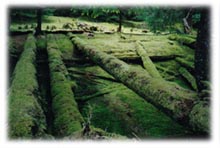 At the turn of the century
white settlers arrived, and with them the small pox, to which most of the
Haida succumbed. The few survivors escaped north to the towns of Skidegate
and Masset. Today, only indentations in the ground, moss-covered roof
beams and posts remain, but one can still sense the spirit of the place. A
path, lined with seashells, leads to the simple grave of renowned Haida
artist Bill Reid.
At the turn of the century
white settlers arrived, and with them the small pox, to which most of the
Haida succumbed. The few survivors escaped north to the towns of Skidegate
and Masset. Today, only indentations in the ground, moss-covered roof
beams and posts remain, but one can still sense the spirit of the place. A
path, lined with seashells, leads to the simple grave of renowned Haida
artist Bill Reid.
The Zodiac has left. Stillness. We stow our gear and launch the boats.
As we paddle to Kunga Island across from us, the sea is calm at first, but
then the southwest wind picks up. Whitecaps start forming. In the lee of
some rocks we eye our goal, Lyell Island, separated from us by a passage
of wind-churned water. Shall we go for it? "It shouldn’t take more than
half an hour," Jake yells behind me, and with the motto "now or never" we
steer our kayak into the waves. Cold spray hits my face and neck, and my
hands tense around the shaft of the paddle. We concentrate on a landmark
on Lyell and start paddling towards it. Once we are near the coast, the
worst is over. We round the northern tip and paddle to Windy Bay
(Hlk’yah), an inlet on Lyell’s East Coast, that once also had a Haida
village. As we pass through the entrance, wind and waves are suddenly
switched off. Calm water, dark forest, a creek and a sandy beach beckon us
to land here. In the shadow of firs, spruce and cedars stands a replica of
a Haida longhouse and a cabin for the Haida watchman, who lives here in
the summer. Today, however, nobody is at home, and we settle into the
longhouse. I am glad to get out of my soaked clothes, but with my cramped
fingers I can barely open the zipper on my life-jacket.
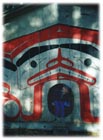 Battleground of
Conservationists Battleground of
Conservationists
During the 1980s, Lyell Island became the staging ground for battles
between conservationists and logging magnates. After year-long
demonstrations and arrests that created a stir internationally, logging in
the southern part of Haida Gwaii was stopped. Today, Gwaii Haanas National
Park covers the southern part of Moresby Island and hundreds of smaller
islands.
Tree Giants
Day 2
We explore the interior of the island. Soft light filters through the
dense branches onto the moss-covered ground. And then we stand in front of
a giant: a tall Sitka-spruce with a diameter of over 20 m. My neck hurts
as I try to view this giant in its entirety. We lie down on the moss and
engage in a quiet dialogue with this wonder of nature. As we continue our
walk, we encounter more tree giants, among them cedars that bear scars on
their bark and burn marks – signs of activities of former Haida
craftsmen.
The cedar was revered by the Haida, because its wood, bark, roots and
needles supplied them with everything they needed to make a living: from
the wood they built houses, canoes and tools, and from the bark and the
roots, household-, hunting- and fishing utensils. And finally, the cedar
supplied the material for ceremonial and artistic articles: totempoles,
mortuary boxes, carvings and masks. "Oh, the cedar tree!
If
mankind in his infancy had prayed for the perfect substance for all
materials and aesthetic needs,
An indulgent god could have provided
nothing better."
(Bill Reid)
In the late afternoon we sit in our kayaks at the entrance of Windy Bay
and bounce our fish hooks, on which we have tied jigs, on the bottom up
and down. The reward: several lingcod. For dinner we enjoy a delicious
fish stew and are entertained by the squabbling of a bald eagle and a
crow.

Island Paradise
Day 3
We leave in the morning with the incoming tide. A strong northerly pushes
us southwards, along the East Coast of Lyell Island. To our left is the
notorious Hecate Straight, which separates the archipelago from the
mainland. Small whitecaps appear on the wave crests and we are running
before the wind, reach the entrance to Juan Perez Sound and fight our way
through to the leeward side of Hotsprings Island (Gandle K’in). It’s low
tide now and we just manage to land our boats on a tiny strip of pebbled
beach. 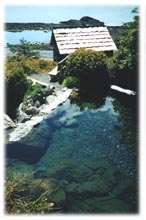 Among heather and small
pine trees we follow a pebbled path until we come upon the feature that
has given the island its name: blue-green, rock-fringed pools, filled with
hot water. Here too is a Haida Watchman’s hut, but nobody is home. In the
bath house we clean ourselves with hot water and then submerge ourselves
up to the neck in the pools. The smell of the pines and the buzzing of
insects have a relaxing effect. In front of us we have a spectacular view
across the sea and towards the snow-covered San Cristobal Range of Moresby
Island. We have found paradise.
Among heather and small
pine trees we follow a pebbled path until we come upon the feature that
has given the island its name: blue-green, rock-fringed pools, filled with
hot water. Here too is a Haida Watchman’s hut, but nobody is home. In the
bath house we clean ourselves with hot water and then submerge ourselves
up to the neck in the pools. The smell of the pines and the buzzing of
insects have a relaxing effect. In front of us we have a spectacular view
across the sea and towards the snow-covered San Cristobal Range of Moresby
Island. We have found paradise.
But camping in paradise is not permitted anymore, so we have to pack up
and continue paddling. In the late afternoon we land on the western tip of
Ramsay Island, erect our tents on moss-covered ground under the trees, and
cook mussels in a pot over a campfire.

Idyllic Islands
Day 4
Brilliant sunshine once again. How can this be? We had been warned about
the rainy weather. We launch the kayaks in a light breeze and paddle
westwards to a group of islands called the Bishoffs. As we get closer, a
magical world opens up: crystal clear water, swaying kelp forests, and a
group of seals, which follows us floating playfully through the passage
between the islands.
 The outgoing tide forces us
to a quick decision about a camping spot. We pitch the tents on a narrow
piece of land, which is almost pinched off by two adjacent bays.
Everywhere around us is life: rocks covered with mussels, tide pools
filled with sea urchins, colorful starfish colonies, and the cute
oystercatchers, who, with their stick-legs, mince around on the washed
over rocks. With the incoming tide we paddle out of our bay once more and
round the islands. In the increasing wind we try our luck at fishing on
the leeward side and return to camp with four fish.
The outgoing tide forces us
to a quick decision about a camping spot. We pitch the tents on a narrow
piece of land, which is almost pinched off by two adjacent bays.
Everywhere around us is life: rocks covered with mussels, tide pools
filled with sea urchins, colorful starfish colonies, and the cute
oystercatchers, who, with their stick-legs, mince around on the washed
over rocks. With the incoming tide we paddle out of our bay once more and
round the islands. In the increasing wind we try our luck at fishing on
the leeward side and return to camp with four fish.
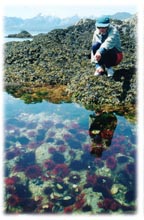 Day
5 Birdsong wakes me at 5 a.m. The sky
is overcast and the wind stirs the water on the south side of our islet.
Jake says it’s too windy to paddle, so I snuggle back into my sleeping
bag. At 8:30 a.m. the wind has dropped, but now it is low tide and the
water in our bay has drained out. So we breakfast leisurely and wait for
the tide. Day
5 Birdsong wakes me at 5 a.m. The sky
is overcast and the wind stirs the water on the south side of our islet.
Jake says it’s too windy to paddle, so I snuggle back into my sleeping
bag. At 8:30 a.m. the wind has dropped, but now it is low tide and the
water in our bay has drained out. So we breakfast leisurely and wait for
the tide.
Mysterious Inlets
A light swell rocks our boats as we round the southern tip of Lyell
Island and cross Juan Perez Sound. In strong winds and waves a crossing
such as this would be too risky because on the open water one would be
exposed to the elements. In the afternoon we steer our boats into a small
bay on the East Coast of Moresby Island, set up camp and take a lunch
break. Afterwards, we get back into our kayaks and explore Kostan Inlet,
the next bay north from our campsite. Soon we are surrounded by steep,
wooded slopes, which gleam with red, orange and purple starfish colonies
below the waterline. A flock of honking Canada geese passes by. Seals
frolic in the dark-green water. The bay narrows. The darkness of the
forest and the water lends a mysterious atmosphere to the surroundings.
Then a rainsquall hits and envelops everything in a gray veil. While we
get out our raincoats, it is already over.

On the way back to our campsite we try our luck at fishing once more.
We return to camp with three fish and a pot full of big mussels. A benign
evening sun tempts me to have a quick wash in the creek. How soft the
water of the creek feels! At dinnertime comes a disappointment: when we
open the big mussels, we discover little crabs inside them. The taste,
too, leaves a great deal to be desired. Disgusted, we throw them to the
seals and seagulls.
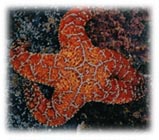 Day
6 Another clear morning. At 10 a.m.
we’re on our way. To reach the southern tip of Shuttle Island, we have to
pass the entrance of Bigsby Inlet, from where strong wind gusts sweep down
from the hillsides. The paddling gets more strenuous. Then the sky
darkens, and as we land on a small beach at the southern tip of Shuttle
Island, light rain begins to fall. We seek cover under a cedar tree. Soon,
the sky is clearing again and we enjoy great views across Juan Perez
Sound. We spend the afternoon with beach combing, reading, and snoozing,
and set off with the incoming tide. Through Hoya Passage we continue
north, first, hugging the coast of Shuttle Island, where, once again, we
admire the numerous starfish colonies. Then we cross Hoya Passage and
follow the coast of Moresby Island. In the evening we enter a narrowing
inlet, until it ends in a meadow with a creek, surrounded by steep
forested hillsides. Here, at Echo Harbor, it appears as if we’re camped on
an alpine meadow, because the narrow inlet bars any views towards the sea.
Only the tides remind us that we are near the coast. Day
6 Another clear morning. At 10 a.m.
we’re on our way. To reach the southern tip of Shuttle Island, we have to
pass the entrance of Bigsby Inlet, from where strong wind gusts sweep down
from the hillsides. The paddling gets more strenuous. Then the sky
darkens, and as we land on a small beach at the southern tip of Shuttle
Island, light rain begins to fall. We seek cover under a cedar tree. Soon,
the sky is clearing again and we enjoy great views across Juan Perez
Sound. We spend the afternoon with beach combing, reading, and snoozing,
and set off with the incoming tide. Through Hoya Passage we continue
north, first, hugging the coast of Shuttle Island, where, once again, we
admire the numerous starfish colonies. Then we cross Hoya Passage and
follow the coast of Moresby Island. In the evening we enter a narrowing
inlet, until it ends in a meadow with a creek, surrounded by steep
forested hillsides. Here, at Echo Harbor, it appears as if we’re camped on
an alpine meadow, because the narrow inlet bars any views towards the sea.
Only the tides remind us that we are near the coast.
In the Footsteps of the Prospectors
Day 7
In the early morning the sky is clear; then it starts to cloud over. With
the incoming tide we leave this protected harbor. Our next destination is
Anna Inlet, another fjord-like bay, where from 1907 to 1928 prospectors
staked claims and fisheries built canneries.
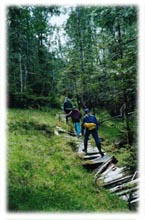 Soon we come
upon a trace from those days: a boardwalk, which leads in switchbacks
upwards in the forest. Curious, we follow it, but there are many times
when we have to make our own way through the brush because this "road of
the goldseekers" disintegrates more and more. An hour later, we reach the
shore of Anna Lake, a dark-green mountain lake. It feels great to stick
the feet into freshwater. After this side trip we paddle a short distance
further north and camp at the end of a tiny bay that offers views of
Klunkwoi Sound and Richardson Island. This is our last night in Gwaii
Haanas National Park, and we enjoy the evening stillness one more time.
During our trip we encountered not a single soul; only occasionally did we
glimpse a fishing boat in the distance.
Soon we come
upon a trace from those days: a boardwalk, which leads in switchbacks
upwards in the forest. Curious, we follow it, but there are many times
when we have to make our own way through the brush because this "road of
the goldseekers" disintegrates more and more. An hour later, we reach the
shore of Anna Lake, a dark-green mountain lake. It feels great to stick
the feet into freshwater. After this side trip we paddle a short distance
further north and camp at the end of a tiny bay that offers views of
Klunkwoi Sound and Richardson Island. This is our last night in Gwaii
Haanas National Park, and we enjoy the evening stillness one more time.
During our trip we encountered not a single soul; only occasionally did we
glimpse a fishing boat in the distance.
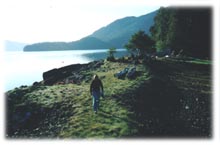 Last
Day In the morning, our tents are
covered in heavy dew, and the grass is frosted over. But a campfire warms
us, and when we paddle into Klunkwoi Sound, the rays of the morning sun
hit us. Now we have only a few more hours to paddle. We have to reach the
next bay, Crescent Inlet, where the outfitter has a floating boathouse. We
had been instructed to arrive there at 11 a.m. and to wait for the Zodiac.
This last day couldn’t have been more beautiful: The snow-covered peaks on
Moresby Island stand out against a deep blue sky, and the sea is
glittering. Last
Day In the morning, our tents are
covered in heavy dew, and the grass is frosted over. But a campfire warms
us, and when we paddle into Klunkwoi Sound, the rays of the morning sun
hit us. Now we have only a few more hours to paddle. We have to reach the
next bay, Crescent Inlet, where the outfitter has a floating boathouse. We
had been instructed to arrive there at 11 a.m. and to wait for the Zodiac.
This last day couldn’t have been more beautiful: The snow-covered peaks on
Moresby Island stand out against a deep blue sky, and the sea is
glittering. 
Shortly before 11 a.m. we arrive at the boathouse, hoist the boats out
of the water and empty them. Then we pack our gear into our dufflebags and
packs, lay down on the warm dock and wait for the Zodiac. Hours pass. We
wish we could continue paddling instead of hanging out here. Bored, we
investigate the hut and find several books, most of them about the culture
and history of Haida Gwaii. A photo of Tanu, taken around the turn of the
century, illustrates what the village once used to look like.
Finally, at 5:30 a.m. the Zodiac arrives, and after an hour of busy
loading, we are ready to depart. As we ride the whitecaps in Hecate
Straight under the roar of the outboard engine, and as the wind chills us
to the bone, I am sad and disappointed that the farewell from Haida Gwaii
has been so abrupt.
|
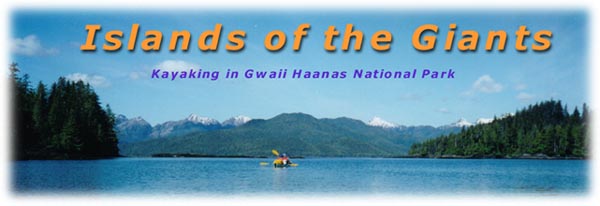
 At the turn of the century
white settlers arrived, and with them the small pox, to which most of the
Haida succumbed. The few survivors escaped north to the towns of Skidegate
and Masset. Today, only indentations in the ground, moss-covered roof
beams and posts remain, but one can still sense the spirit of the place. A
path, lined with seashells, leads to the simple grave of renowned Haida
artist Bill Reid.
At the turn of the century
white settlers arrived, and with them the small pox, to which most of the
Haida succumbed. The few survivors escaped north to the towns of Skidegate
and Masset. Today, only indentations in the ground, moss-covered roof
beams and posts remain, but one can still sense the spirit of the place. A
path, lined with seashells, leads to the simple grave of renowned Haida
artist Bill Reid. Battleground of
Conservationists
Battleground of
Conservationists

 Among heather and small
pine trees we follow a pebbled path until we come upon the feature that
has given the island its name: blue-green, rock-fringed pools, filled with
hot water. Here too is a Haida Watchman’s hut, but nobody is home. In the
bath house we clean ourselves with hot water and then submerge ourselves
up to the neck in the pools. The smell of the pines and the buzzing of
insects have a relaxing effect. In front of us we have a spectacular view
across the sea and towards the snow-covered San Cristobal Range of Moresby
Island. We have found paradise.
Among heather and small
pine trees we follow a pebbled path until we come upon the feature that
has given the island its name: blue-green, rock-fringed pools, filled with
hot water. Here too is a Haida Watchman’s hut, but nobody is home. In the
bath house we clean ourselves with hot water and then submerge ourselves
up to the neck in the pools. The smell of the pines and the buzzing of
insects have a relaxing effect. In front of us we have a spectacular view
across the sea and towards the snow-covered San Cristobal Range of Moresby
Island. We have found paradise.

 The outgoing tide forces us
to a quick decision about a camping spot. We pitch the tents on a narrow
piece of land, which is almost pinched off by two adjacent bays.
Everywhere around us is life: rocks covered with mussels, tide pools
filled with sea urchins, colorful starfish colonies, and the cute
oystercatchers, who, with their stick-legs, mince around on the washed
over rocks. With the incoming tide we paddle out of our bay once more and
round the islands. In the increasing wind we try our luck at fishing on
the leeward side and return to camp with four fish.
The outgoing tide forces us
to a quick decision about a camping spot. We pitch the tents on a narrow
piece of land, which is almost pinched off by two adjacent bays.
Everywhere around us is life: rocks covered with mussels, tide pools
filled with sea urchins, colorful starfish colonies, and the cute
oystercatchers, who, with their stick-legs, mince around on the washed
over rocks. With the incoming tide we paddle out of our bay once more and
round the islands. In the increasing wind we try our luck at fishing on
the leeward side and return to camp with four fish. Day
5 Birdsong wakes me at 5 a.m. The sky
is overcast and the wind stirs the water on the south side of our islet.
Jake says it’s too windy to paddle, so I snuggle back into my sleeping
bag. At 8:30 a.m. the wind has dropped, but now it is low tide and the
water in our bay has drained out. So we breakfast leisurely and wait for
the tide.
Day
5 Birdsong wakes me at 5 a.m. The sky
is overcast and the wind stirs the water on the south side of our islet.
Jake says it’s too windy to paddle, so I snuggle back into my sleeping
bag. At 8:30 a.m. the wind has dropped, but now it is low tide and the
water in our bay has drained out. So we breakfast leisurely and wait for
the tide.
 Day
6 Another clear morning. At 10 a.m.
we’re on our way. To reach the southern tip of Shuttle Island, we have to
pass the entrance of Bigsby Inlet, from where strong wind gusts sweep down
from the hillsides. The paddling gets more strenuous. Then the sky
darkens, and as we land on a small beach at the southern tip of Shuttle
Island, light rain begins to fall. We seek cover under a cedar tree. Soon,
the sky is clearing again and we enjoy great views across Juan Perez
Sound. We spend the afternoon with beach combing, reading, and snoozing,
and set off with the incoming tide. Through Hoya Passage we continue
north, first, hugging the coast of Shuttle Island, where, once again, we
admire the numerous starfish colonies. Then we cross Hoya Passage and
follow the coast of Moresby Island. In the evening we enter a narrowing
inlet, until it ends in a meadow with a creek, surrounded by steep
forested hillsides. Here, at Echo Harbor, it appears as if we’re camped on
an alpine meadow, because the narrow inlet bars any views towards the sea.
Only the tides remind us that we are near the coast.
Day
6 Another clear morning. At 10 a.m.
we’re on our way. To reach the southern tip of Shuttle Island, we have to
pass the entrance of Bigsby Inlet, from where strong wind gusts sweep down
from the hillsides. The paddling gets more strenuous. Then the sky
darkens, and as we land on a small beach at the southern tip of Shuttle
Island, light rain begins to fall. We seek cover under a cedar tree. Soon,
the sky is clearing again and we enjoy great views across Juan Perez
Sound. We spend the afternoon with beach combing, reading, and snoozing,
and set off with the incoming tide. Through Hoya Passage we continue
north, first, hugging the coast of Shuttle Island, where, once again, we
admire the numerous starfish colonies. Then we cross Hoya Passage and
follow the coast of Moresby Island. In the evening we enter a narrowing
inlet, until it ends in a meadow with a creek, surrounded by steep
forested hillsides. Here, at Echo Harbor, it appears as if we’re camped on
an alpine meadow, because the narrow inlet bars any views towards the sea.
Only the tides remind us that we are near the coast. Soon we come
upon a trace from those days: a boardwalk, which leads in switchbacks
upwards in the forest. Curious, we follow it, but there are many times
when we have to make our own way through the brush because this "road of
the goldseekers" disintegrates more and more. An hour later, we reach the
shore of Anna Lake, a dark-green mountain lake. It feels great to stick
the feet into freshwater. After this side trip we paddle a short distance
further north and camp at the end of a tiny bay that offers views of
Klunkwoi Sound and Richardson Island. This is our last night in Gwaii
Haanas National Park, and we enjoy the evening stillness one more time.
During our trip we encountered not a single soul; only occasionally did we
glimpse a fishing boat in the distance.
Soon we come
upon a trace from those days: a boardwalk, which leads in switchbacks
upwards in the forest. Curious, we follow it, but there are many times
when we have to make our own way through the brush because this "road of
the goldseekers" disintegrates more and more. An hour later, we reach the
shore of Anna Lake, a dark-green mountain lake. It feels great to stick
the feet into freshwater. After this side trip we paddle a short distance
further north and camp at the end of a tiny bay that offers views of
Klunkwoi Sound and Richardson Island. This is our last night in Gwaii
Haanas National Park, and we enjoy the evening stillness one more time.
During our trip we encountered not a single soul; only occasionally did we
glimpse a fishing boat in the distance. Last
Day In the morning, our tents are
covered in heavy dew, and the grass is frosted over. But a campfire warms
us, and when we paddle into Klunkwoi Sound, the rays of the morning sun
hit us. Now we have only a few more hours to paddle. We have to reach the
next bay, Crescent Inlet, where the outfitter has a floating boathouse. We
had been instructed to arrive there at 11 a.m. and to wait for the Zodiac.
This last day couldn’t have been more beautiful: The snow-covered peaks on
Moresby Island stand out against a deep blue sky, and the sea is
glittering.
Last
Day In the morning, our tents are
covered in heavy dew, and the grass is frosted over. But a campfire warms
us, and when we paddle into Klunkwoi Sound, the rays of the morning sun
hit us. Now we have only a few more hours to paddle. We have to reach the
next bay, Crescent Inlet, where the outfitter has a floating boathouse. We
had been instructed to arrive there at 11 a.m. and to wait for the Zodiac.
This last day couldn’t have been more beautiful: The snow-covered peaks on
Moresby Island stand out against a deep blue sky, and the sea is
glittering. 

